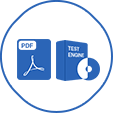Last Update 7 hours ago Total Questions : 155
The Oklahoma Life, Accident, and Health or Sickness Producer Exam content is now fully updated, with all current exam questions added 7 hours ago. Deciding to include Ok-Life-Accident-and-Health-or-Sickness-Producer practice exam questions in your study plan goes far beyond basic test preparation.
You'll find that our Ok-Life-Accident-and-Health-or-Sickness-Producer exam questions frequently feature detailed scenarios and practical problem-solving exercises that directly mirror industry challenges. Engaging with these Ok-Life-Accident-and-Health-or-Sickness-Producer sample sets allows you to effectively manage your time and pace yourself, giving you the ability to finish any Oklahoma Life, Accident, and Health or Sickness Producer Exam practice test comfortably within the allotted time.
An insured with a major medical policy has a per cause deductible of $100. Over the course of the year, the insured visits the doctor’s office three times for injuries. Excluding the premium, what is the MINIMUM amount the insured MUST pay for the year if each visit costs $200?
A condition for which medical advice, diagnosis, care, or treatment was recommended or received during the 6 months immediately preceding the effective date of group health coverage is
Which of the following is NOT a right of the life insurance policyowner?
From an insured’s perspective, what is the PRIMARY and MOST attractive feature of a viatical settlement?
The type of insurance used to indemnify a firm for the loss of earnings brought about by the death or disability of an officer or other significant employee is
An insured receives a notice from the insurer that the policy has been cancelled in the middle of the term. Which of the following policies did the insured MOST likely have?
Under the Fair Credit Reporting Act, a consumer report includes

